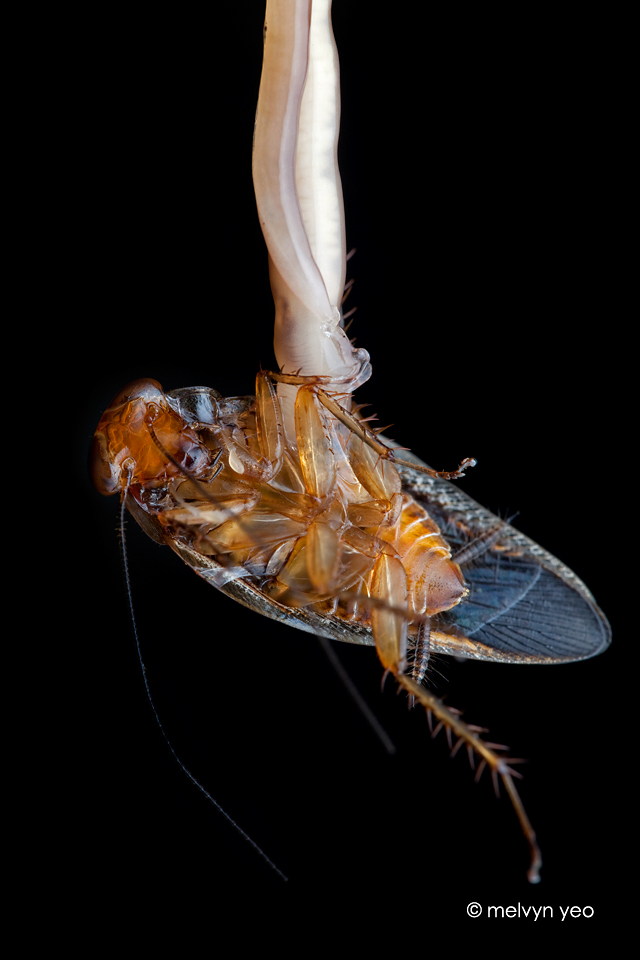ShopDreamUp AI ArtDreamUp
Deviation Actions
Description
Close up. Another view 
Quote from en.wikipedia.org/wiki/Nemertea
The proboscis is an infolding of the body wall, and sits in the rhynchocoel when inactive. When muscles in the wall of the rhynchocoel compress the fluid in the rhynchocoel, the pressure makes the proboscis jump inside-out to attack the animal's prey along a canal called the rhynchodeum and through an orifice, the proboscis pore. The proboscis has a muscle which attaches to the back of the rhynchocoel, and which can stretch up to 30 times its inactive length and then retract the proboscis.
The proboscis of the class Anopla ("unarmed") exits from an orifice which is separate from the mouth, coils around the prey and immobilizes it by sticky, toxic secretions. The Anopla can attack as soon as they move into the range of the proboscis. Some Anopla have branched proboscises which Ruppert, Fox and Barnes describe as "a mass of sticky spaghetti". The animal then draws its prey into its mouth.
In most of the class Enopla ("armed"), the proboscis exits from a common orifice of the rhynchocoel and mouth. A typical member of this class has a stylet, a calcareous barb, with which the animal stabs the prey many times to inject toxins and digestive secretions. The prey is then swallowed whole or, after partial digestion, its tissues are sucked into the mouth.[20] The stylet is attached about one-third of distance from the end of the everted proboscis, which extends only enough to expose the stylet. On either side of the active stylet are sacs containing back-up stylets to replace the active one as the animal grows or an active one is lost. Instead of one stylet, the Polystilifera have a pad that bears many tiny stylets, and these animals have separate orifices for the proboscis and mouth, unlike other Enopla. The Enopla can only attack after contacting the prey.
Some nemerteans, such as L. longissimus, absorb organic food in solution through their skins, which may make the long, slim bodies an advantage. Suspension feeding is found only among the specialized symbiotic bdellonemerteans, which have a proboscis but no stylet, and use suckers to attach themselves to bivalves

Quote from en.wikipedia.org/wiki/Nemertea
The proboscis is an infolding of the body wall, and sits in the rhynchocoel when inactive. When muscles in the wall of the rhynchocoel compress the fluid in the rhynchocoel, the pressure makes the proboscis jump inside-out to attack the animal's prey along a canal called the rhynchodeum and through an orifice, the proboscis pore. The proboscis has a muscle which attaches to the back of the rhynchocoel, and which can stretch up to 30 times its inactive length and then retract the proboscis.
The proboscis of the class Anopla ("unarmed") exits from an orifice which is separate from the mouth, coils around the prey and immobilizes it by sticky, toxic secretions. The Anopla can attack as soon as they move into the range of the proboscis. Some Anopla have branched proboscises which Ruppert, Fox and Barnes describe as "a mass of sticky spaghetti". The animal then draws its prey into its mouth.
In most of the class Enopla ("armed"), the proboscis exits from a common orifice of the rhynchocoel and mouth. A typical member of this class has a stylet, a calcareous barb, with which the animal stabs the prey many times to inject toxins and digestive secretions. The prey is then swallowed whole or, after partial digestion, its tissues are sucked into the mouth.[20] The stylet is attached about one-third of distance from the end of the everted proboscis, which extends only enough to expose the stylet. On either side of the active stylet are sacs containing back-up stylets to replace the active one as the animal grows or an active one is lost. Instead of one stylet, the Polystilifera have a pad that bears many tiny stylets, and these animals have separate orifices for the proboscis and mouth, unlike other Enopla. The Enopla can only attack after contacting the prey.
Some nemerteans, such as L. longissimus, absorb organic food in solution through their skins, which may make the long, slim bodies an advantage. Suspension feeding is found only among the specialized symbiotic bdellonemerteans, which have a proboscis but no stylet, and use suckers to attach themselves to bivalves
Image size
640x960px 229.41 KB
Make
Canon
Model
Canon EOS 5D Mark II
Shutter Speed
1/125 second
Aperture
F/16.0
Focal Length
100 mm
ISO Speed
100
Date Taken
Nov 1, 2013, 11:10:17 PM
Sensor Size
4mm
© 2013 - 2024 melvynyeo
Comments4
Join the community to add your comment. Already a deviant? Log In
No thanks






























